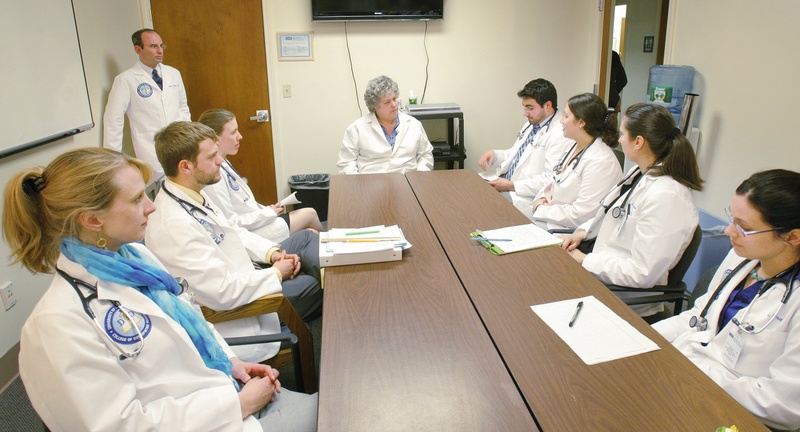PLAINFIELD, Vt. — Ronald Pitkin, 84, remembers the day in the early 1960s when his brother Belmont got a gash in his leg while the two were cutting firewood. They went to the office of the town physician, Dr. Frank Corson.
Corson worked alone, and Pitkin was drafted to be his assistant. “He told me ‘You’re going to have to scrub up.’ I was the operating room nurse that day.”
Now Pitkin gets his health care at The Health Center, a sleek, modern clinic that houses primary care, dentistry, psychiatry and other specialties under one roof. It’s one of eight facilities in small towns around Vermont that charge based on patients’ ability to pay. They provide primary care to about 25 percent of the mostly rural state’s residents, and experts say they’re a key part of the reason why Vermont leads the country in primary care doctors per capita.
“This is a terrific health care center,” Pitkin said recently as he waited for a checkup with the center’s senior physician, Dr. John Matthew. “It’s more care, and help in general, for less dollars than just about anywhere.”
With Vermont leading the way, five of New England’s six states rank in the top six for primary care doctors per capita, according to data from the Association of American Medical Colleges. The sixth, Connecticut, ranks 12th. As the national shortage of primary care doctors expected to increase after the federal Affordable Care Act takes full effect next year, some are looking to New England’s states with an eye to what they’ve been doing right.
Several factors contribute to New England’s relatively strong position. Among them: strong public health programs ensuring that high percentages of residents have health coverage, meaning fewer doctors deliver uncompensated care. Massachusetts, which enacted a universal health care program in 2006, has about 97 percent of its residents carrying health coverage. In Vermont it’s about 94 percent.
The high rates of people already insured means “we will not experience the same (influx of newly insured patients) in Vermont as in other states that have very high rates of uninsured people or low Medicaid eligibility,” said Mark Larson, commissioner of the Vermont Department of Health Access.
Medical schools in New England, including the University of Vermont College of Medicine and the University of Massachusetts Medical School, have increased their emphasis on educating doctors for primary care in recent years, officials said. Vermont and New Hampshire augment a federal program that offers partial loan forgiveness for doctors willing to work in under-served areas with a similar state program.
In rural northern New Hampshire, Edward Shanshala, executive director of Ammonoosuc Community Health Services, said he tries to use the lifestyle as a lure when recruiting new doctors. “If you like to hike, bike, ski, fish and things like that – great!” he said.
Doctors also have time to see more patients because physician’s assistants and nurses deliver some basic care to patients, said Brian Rosman of the Boston-based consumer group Health Care for All.
“The goal is to have everybody working at the top of their license,” Rosman said. “Doctors should do things that really need doctors.”
At The Health Center in Plainfield, the nine-member medical staff comprises both doctors and physicians’ assistants, Matthew said. Salaries are not as high there as in more urban areas. The newest doctor on staff, Elisha McLam, said she could be making significantly more elsewhere. But the Williamstown native and UVM College of Medicine graduate said she wanted to work in her native state.
Even in New England, though, the picture is “far from rosy,” said Dr. Joseph Gravel, president of the Massachusetts Academy of Family Physicians. Starting family physicians at his Lawrence office make $130,000 a year; specialists can make three or four times that much, Gravel said. With many new doctors facing student loan debts in the hundreds of thousands of dollars, the incentives are clear.
And the need for care is increasing, too, as the general population ages. Maine has the nation’s highest median age; Vermont is second.
“It seems like not only is Maine’s general population aging, but a significant percentage of primary care practitioners is also getting to an age of retirement,” said Vanessa Santarelli, CEO of the Maine Primary Care Association, which promotes and supports 20 federally qualified health centers across the state.
And sometimes the hiking, skiing and fishing just aren’t big enough attractions, Shanshala said. He described some of the lengths to which he’s gone to recruit physicians. When doctors in training leave after brief stints, he invites them to return for the company picnic and tries to keep in touch in case they ever want to come back.
Still, the picture in New England is better than elsewhere, Gravel said. He cited a 2007 report in the Journal of the American Medical Association saying that among new medical school graduates just beginning their residencies, just 3.3 percent nationwide were going into family practice.
Strong support from the community and from Vermont’s political leadership were among the chief satisfactions of Matthew’s 40-plus-year career, he said.
“Vermont is a good society,” he said. “Everyone is concerned about the least amongst us.”
AP writers Holly Ramer in Concord, N.H., and David Sharp in Portland, Maine, contributed to this report.
Send questions/comments to the editors.



Success. Please wait for the page to reload. If the page does not reload within 5 seconds, please refresh the page.
Enter your email and password to access comments.
Hi, to comment on stories you must . This profile is in addition to your subscription and website login.
Already have a commenting profile? .
Invalid username/password.
Please check your email to confirm and complete your registration.
Only subscribers are eligible to post comments. Please subscribe or login first for digital access. Here’s why.
Use the form below to reset your password. When you've submitted your account email, we will send an email with a reset code.